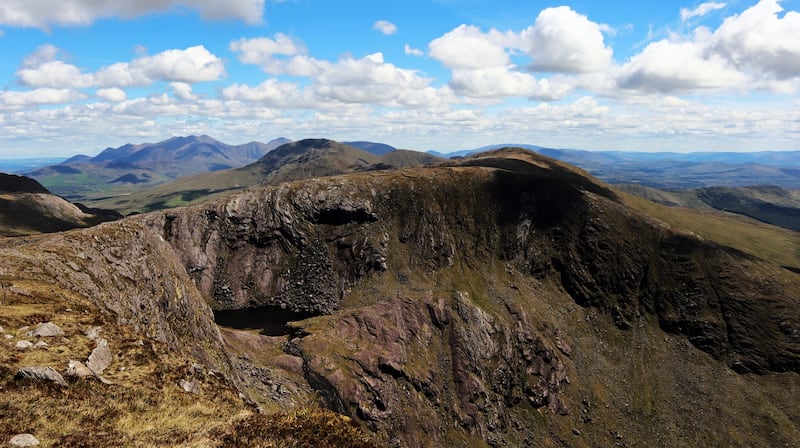The Magillicuddy Reeks are rightly noted for their aretes, those dramatically narrow serrated crests that provide exciting scrambling while enhancing the skyline of the northern ridges of the Iveragh Peninsula.
Further south, the Dunkerron range provides no such dramatic outlines as the southward moving ice sheets planed off the summits to create an uneven plateau surface.
This provides for nice, easy, uneventful walking – until you drift towards the edges. Looking down, you are captivated by the chiselled beauty of the great hollows that the ice carved out of the sides of the massif.
These cooms (hollows) often contain a lake (tarn) and waterfalls which add to their attractiveness. So, the eastern edge of the Dunkerrons will give you superb views not only of these cliff-bound basins but also splendid panoramas of Kenmare Bay and the Beara Peninsula.
Michael Murphy’s farmyard is always an excellent place to start. Murphy is most welcoming to walkers and always happy to give advice on routes. He has even put in a couple of stiles to help the weary walker. If he has time you might also get a cup of tea while he regales you with tales of misfortunes that befell unwary walkers on these uplands and the exploits of climbers who conquered the cliffs

Easy navigating
A track leads on to the plateau and as you walk down the northern spur of Knocknagantee (676m) you will get a superb view of the rock-basin lake of Coomanassaig, with a waterfall tumbling down to Lough an Iolar (Eagle’s Lake).
Though the ground is littered with large boulders dumped by the ice, it is easy to negotiate your way through them and up on to the spur that leads to Coomachronia (636m). From this opposite side, the view down into this natural amphitheater is even more impressive.
It is hard to imagine that this was once just a small depression in the mountainside that became filled with ice. As the Ice Age advanced, a complex process of freezing and thawing shattered the rock under the ice and increased the depth of the concavity.
When the volume of ice in such a location reaches a critical mass, it begins to move in a circular motion and, due to the rock particles frozen to it, acts as a giant abrasive: widening and deepening the hollow while freeze-thaw action plucks large blocks of rock from the mountainside.
After the ice has melted the coom is revealed in its sculpted magnificence with a distinctive bowl shape, a steep head-wall ravaged with fissures enlivened by tumbling cascades in wet weather and a rock lip damming the waters of the tarn, which can vary in colour from a sparking blue to a brooding black in an instant.
The walk across to Finnararagh (667m) is a delight. Great drops on your right go down to the tarns of Coomnacronia and Lough Coomeen, from which stretch the wooded lowlands of Iveragh to the shining waters of Kenmare Bay.
The route back is along the rock lips of the cooms, where you get a totally different perspective as you gaze across at the cliffs whose tops you have just traversed.
Finneraragh Ridge Sneem, Co Kerry
Map: Ordnance Survey. Discovery Series. Sheet 78 & 84
Start & finish: At a wide space beside a farmhouse and barn, 5km north of Sneem.
Grid reference: 668 712
How to get there: Coming from Kenmare on the N70, cross over the bridge in the village and turn right at the signpost for Sneem Burial Ground and the Lomanagh & Fermoyle Walks. Keep left at the first fork and uphill over Lomanagh Bridge. Then keep left at the next fork. The parking spot for a few cars is just beyond the forestry plantation.
Time: 5 hours
Distance: 14km
Total ascent: 900m
Suitability: Route is Moderate. Boots and Rain gear essential.
Food & accommodation: Sneem. Waterville. Bru na Dromoda Hostel near Waterville is top class and designed for walkers, hikers and cyclists.











